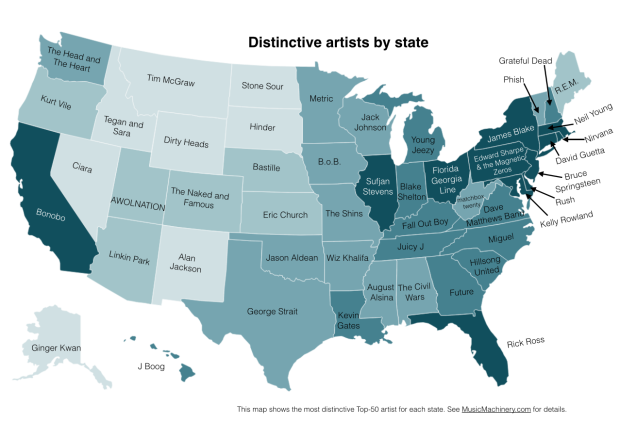Over the past few years, music subscription services have seen incredible growth, with revenues up by 51 percent in 2013 and the $1 billion threshold crossed. In contrast to that, over a decade of stagnation has seen Europe’s overall record sales grow by just 4.3 percent. Undoubtedly, services like Spotify, Deezer, Grooveshark and Pandora have all played a major role in maintaining the industry’s steady progress.
These companies have revolutionised the way people listen to music – especially Spotify which delivered about 4.5 billion hours listening time in 2013 alone – and it is beyond doubt that their use of big data has played a pivotal role in the way the industry has evolved. These streaming services use data not only to enhance engagement and provide a personalised experience, but also to discover upcoming artists and make forecasts on their potential for success.
Spotify, which is allegedly preparing for an IPO later this year, is a great example of the power of big data analytics. With over 6 million paying subscribers, 1.5 billion playlists and more than 20 million songs, an estimated 1.5 terabytes of compressed data is produced daily. More poignantly, the company has one of the biggest commercial Hadoop clusters in Europe, with over 694 heterogeneous nodes running approximately 7,000 jobs a day.

Interestingly, the company used its collection of data last year to see whether the decisions of the Recording Academy (the people who vote on the winners at the Grammy Awards) reflected the habits the public on the streaming service. Out of 8 categories, Spotify attempted to predict the winners by looking at its users’ data (listening habits, subscribers to a playlist, popularity of an artist, etc.) The accuracy? 67%. That figure may seem low, but you should consider how many nominees had to be considered.
Spotify’s predictive capabilities will only improve. In March, the company spent $200 million to acquire Echo Nest, one of a number of companies involved in music analytics and recommendation technology. The company mines data from millions of songs and has compiled about a trillion data points from 35 million songs by 2.5 million artists.
As Echo Nest’s co-founder, Brian Whitman, describes:
“We crawl the web constantly, scanning over 10 million music related pages a day….Every word anyone utters on the Internet about music goes through our systems that look for descriptive terms, noun phrases and other text and those terms bucket up into what we call “cultural vectors” or “top terms.””
Examples pertaining to big data analytics are not confined to Spotify; they are widespread across the industry. Earlier this year The Guardian reported on music analytics firm, MusicMetric, was able to predict with 90% accuracy who would be number one three months in the future. Describing the process involved, Gregory Mead, the chief executive behind Semetric (the company behind MusicMetric), said:
“It’s no different to a sensor in a factory that’s detecting vibrations on a machining piece and when the vibrations start vibrating in a particular way they can detect that it’s going to fail….For a big artist like Katy Perry, there’s about 19,000 different signals we have just for that artist.
With this data, MusicMetrics can turn those “signals into useful information a manager can use when deciding where to take their artist on tour, or that a talent scout can use when deciding which recommendations are worth following up.” (Source)
Similarly, Shazam utilises a combination of critics’ reviews and the number of times people look up a song to judge an artist’s popularity. In so doing, it can predict which songs, and in which cities, a particular artist will gain recognition.
For example, when ID tags showed up in Shazam’s database identifying that the rapper SoMo’s single “Rise” was being searched in Baton Rouge, Louisiana, and Phoenix, the artist’s label, Republic Records, made the decision to push the song to other major cities in the States — landing it in iTunes’ R&B Top 10 a short while after. As Peter Szabo, Shazam’s head of music, notes:
“Our data has shown that we can typically predict 33 days in advance what’s going to be at the top of the Billboard Hot 100. It’s fun to see the epidemic start to spread — the growth of these songs, starting in a city.”
Unsurprisingly, Shazam’s predictive capabilities are garnering serious corporate attention. Warner Music Group signed a deal with the app this February, and interest from record companies has reached a level that Shazam is considering charging companies for additional statistical insights.
Music is becoming yet another industry to embrace data as a powerful resource. Where an artist’s success would once have relied on time and some degree of luck, the music industry is now leveraging data science to harness consumer insights and encourage emerging talent at its most nascent stages.
 Furhaad worked as a researcher/writer for The Times of London and is a regular contributor for the Huffington Post. He studied philosophy on a dual programme with the University of York (U.K.) and Columbia University (U.S.) He is a native of London, United Kingdom.
Furhaad worked as a researcher/writer for The Times of London and is a regular contributor for the Huffington Post. He studied philosophy on a dual programme with the University of York (U.K.) and Columbia University (U.S.) He is a native of London, United Kingdom.
Email: [email protected]
Interested in more content like this? Sign up to our newsletter, and you wont miss a thing!
[mc4wp_form]
(Image Credit: Rich Jacques)





